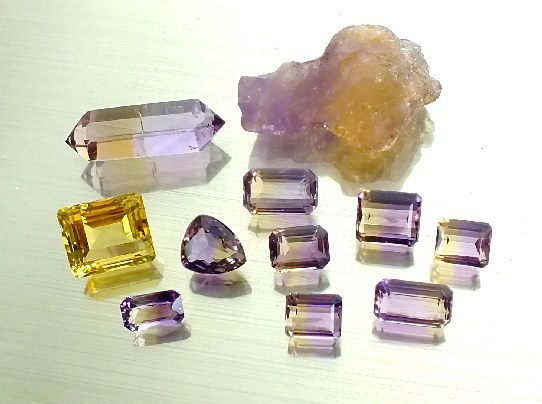 |
| �A���g���������y106ct52x33x28mm�z�ƃ��[�X�@5.53-9.59ct�@ ���F�Ǝ��̃��[�X�@3.16ct�@�J�i���[�F�̃V�g�����@19.74ct�@ |
| Anahi Mine, Bolivia |
�@
���������E�A���g����(Ametrine)
 |
| �A���g���������y106ct52x33x28mm�z�ƃ��[�X�@5.53-9.59ct�@ ���F�Ǝ��̃��[�X�@3.16ct�@�J�i���[�F�̃V�g�����@19.74ct�@ |
| Anahi Mine, Bolivia |
 |
 |
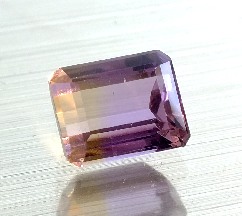 |
 |
 |
| ������͂������[�X�@33.92ct�@35.0x13.2x8.6mm | 7.28ct 13.8x11.6x7.5mm | 5.53ct 10.8x8.9x6.4mm | 5.62ct 10.8x8.7x6.6mm | 6.19ct 12.0x9.0x7.0mm |
 |
 |
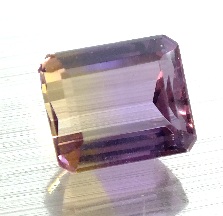 |
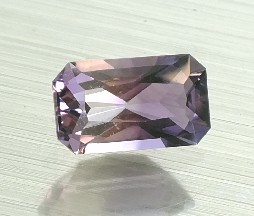 |
 |
| 7.06ct 15.0x8.6x6.4mm | 8.30ct 13.8x10.9x7.0mm | 9.59ct 15.7x9.8x7.3mm | 3.16ct 12.1x7.1x5.3mm | 19.74ct 17.49x14.92x10.00 |
�@1970�N�㏉�ߍ�����u���W���ƃp���O�A�C��ʂ��Đ��E�̕�Ύs��ɁC�������ʂł͂���܂����C��̐Ɏ��Ɖ��F�Ƃ̓�F��������Ȑ��������ʂ��n�߂܂����B
�@��ʂ̕���i�����̕��ʂ̃J�b�g�ɉ����āC�ꕔ�̃J�b�^�[��f�U�C�i�[�B���z�F�̖��������������a�V�Ŏ��R�ȃJ�b�g���{������i�\����悤�ɂȂ��Ď���ɐl�C�����܂�C1980�N�㏉�߂ɂ͐����Ƃ��Ă͈ٗ�̍��l�̃J���b�g����6�` 30�h�����̔��l��������قǂɂȂ�܂����B
�@Starting from early 1970's, strange bi-color quartz with purple and yellow began to appear into world's gem trade, through Brazil and Paraguay.
Fantastic bi-color inspired some gem cutters and designer to create fresh free-form faceting, which generated an excitement to fetch extraordinary high price of US$6 �`30 per carat for quartz in early 1980's.�@
���āC�A���`�X�g�ƃV�g�����̐F��������A���g�����ƌĂ��悤�ɂȂ������̐����������ō̂��̂��H
�@�@���ʃ��[�g��H���āC�E���O�A�C�����߂��̃��I�E�O�����f�B�C�{���r�A�C���邢�̓{���r�A�����̃}�g�E�O���b�\�B���X�C��̐��ƒB�ɂ���ėl�X�Ȑ����������܂����B
�@��ɕ�܂ꂽ���̓�F�̐F�������V�R�̔��F�Ȃ̂��C���邢�͐l�H�I�ȏ����ɂ����̂��@�H�@����ɁC�������̂��V�R�̂��̂��C���邢�͍����ł͂Ȃ��̂��Ɨl�X�ȋc�_���������C���̑f���ɂ��Ă̋^�f�����܂��Ă���1981�N�C�h���̓u���W���̂���H��ō��ꂽ�����i�h�Ƃ̂܂��Ƃ��₩�ȉ\���L����C���i�͍����̓��ɃJ���b�g����P�h���ւƖ\�����鑛���܂ŋN�������̂ł����B
�@This bi-color quartz�Abeing named ametrine after amethyst and citrine color, created suspicions too, for it's origine. From where comes are they ? When pressed for its exact whereabouts, dealers gave conflicting answeres. "I was told the gem came from Brazil, Urguay and Bolivia." If this bi-color is natural or artificial ? If the quartz itself is natural or synthetic ? In the midst of boiling arguments in 1981, a rumor ran that ametrine is synthesized in Brazil, and the fledgling market for this gem collapsed like a soufflé. Prices for free and calibrated sized which had spanned from $6 to $30 per carat toppled to between $2 and $10 per carat.
�@�@�@�@�@
���Ƃ̌����iInvestigations by experts)
�@
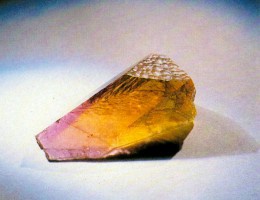 |
 |
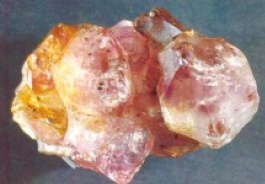 |
| �i�b�\�[���m�������I�ɍ����ƓV�R���������M�ƕ��ː��������č�����A���g���� �iAmetrines, experimentaly heat and irradation treated from synthetic and natural quartzs by Dr. Kurt Nassau)�@ |
�t�����X�ŏ������ꂽ�A���g���� (Partly amethystized citrine by heat and irradiation treatment in France) | |
| ���������iSynthetic quartz�j 3cm | �u���W���Y������ (Brazilian amethyst) 12mm | Revue de Gemmologie 1988 March |
�@ �A���g�����ɂ��Ă̌�����1970�N��ɂȂ菭�Ȃ���ʎ��������\����Ă��܂��B
1980�N�č��� �hGems�@���@Gemology�h �ŁC������GIA�T���^���j�J�̌������ł�������E�����w�ҁCJohn�@Koivula�ɂ��L���ł͖`���ő��F�����������̑��݂͍z���⌋���̐��ƂɂƂ��Ă͑傢�Ȃ��ł�����19���I���߂��� Sir. David Brewster, E.S.Dana, Clifford Frondel�����B�X������Ƃ̌����̑Ώۂł������C�Əq�ׂ��Ă��܂��B
�@There are not a few studies announced on ametrine in 1970's.
Dr. John Koivula, Mineralogist-Gemologist at GIA Santa Monica describes in Gems & Gemology 1980 Summer as follows ; Long known to mineralogists and crystallographers, having been studied since the early 1800's by such notable researchers as Sir David Brewster, E.S. Dana, and Clifford Frondel, sectorally color zoned quartz seems to be somewhat of a mystery to the gemological community.
�@�����čŋߎs��Ɍ��ꂽ��F�̐����ɂ��Ă̓E���O�A�C�����ɋ߂����I�E�O�����f�E�h�E�X�[���̔閧�̍z�R�Y�ƕ���Ă���Ƃ�����Ō������s���܂����B
�@���ɂ��̓����ɂ͎��������O���̓S�C�I���ɂ��J���[�E�Z���^�[�̔��F�C���ꂪ���ː��Ǝ˂ɂ���ĉ������ƂȂ鎖�͊��s���ꂽ�����Kurt�@Nassau�����́hGems�@Made�@By�@Man�h�ɂ���Ė��炩�ɂ���Ă��܂����B
�@�����ĐV���ɓo�ꂵ����F�̐��������Ɖ��F�̕����Ƃ����R�ƐF��������Ă��鎖�ɒ��ڂ��āC���������̐������Ɍ����ʂ̐��ʂƕ��ʂƂł͕s�����̓S�C�I������荞�ޔ䗦�ɑ傫�ȈႢ�����邱�Ƃ��w�E���Ă��܂��B
�@����Ɍ����Ό��ɂ��ώ@�Ŏ������̕������u���W�����o���ł��鎖���w�E���āC���ꂪ���R�Ƃ����F�����Ɋ֘A�����邱�Ƃ��w�E���Ă��܂��B
�@�c�O�Ȃ���C����ȏ�̉𖾂ɂ͎���܂���ł������C���������Ɋj�S�ɔ���w�E�͗��C�����w�̑��l�҂ɑ������������ł���ƌ����܂��傤�B
�@Then he extended the study on the newly arrived ametrine from a somewhat secret Brazilian locality reported to be in the mining area of Rio Grande Do Sul, near the Uruguayan border.
Already at that time coloring mechanism of citrine and amethyst had been revealed by "Gems Made By Man" just published by Dr. Kurt Nassau.
�@ Dr. Koivula pointed out following vital factors on segmentary zoned bi-color quartz ;
1. Quartz has a greater affinity for absorbing iron impurities on the positive rhombohedrons of the terminations than other faces as the crystal grows.
2. Brazil twinning and segmental coloration gives rise to some beautiful and startling optical effects under polarized light.
Although Dr. Koivula could not reveal the entire mechanism of bi-colored quartz growth, these comments were fundamental points to reach to the answer.
�@�hGems�@&�@Gemology�h ��1981�N�t���ɕ�ΊE�̌��Ђł�����Kurt�@Nassau ���m���A���g�����͍����܂��͓V�R�̎����������������\���������ƁC�V�R�ɑ���ے�I�ȋc�_��W�J���܂����B
�@�i�b�\�[���m�͎s��ɗ��ʂ���A���g�����̑f���������ɂȂ��Ă��B���ł��邱�Ƃɋ����^�f������Ă������߁C���獇�������ƃu���W���Y�������Ƃ��������Ďs��ɏo�܂���Ă���A���g�����Ƃ�������̎ʐ^�����J���C���ꂪ�s��Ś�����Ă����^�f�Ɍ���I�ȏ؋��Ƃ��đ�\���������܂����B
�@On Gems & Gemology 1981 Spring article, a renowned gemologist Dr. Kurt Nassau demonstrated the artifically treated ametrine. He could transfer both natural and synthetic amethysts to ametrine, by controling heating temperatures and irradiation levels and declared the great possibility that newly arrived ametrine in the market as artificially treated. No matter that Nassau's case was based on supposition rather than hard proof. The mere chance ametrine cme from a lab was evidende enough. A traumatized trade shunned the quartz.
�@
�@�t�����X�̕�Ίw��� �hrevue de gemmologie�h 1988�N3���� ���������������܂��čl�@�ƁC���M�ƕ��ː��Ǝ˂ɂĎ��������ꕔ�������ɕς���������s���Ă��܂��B
�@����������ꂽ���ʂƍl�@�̌��ʁC�A���g�����͎��R�̂��̂ł͂��蓾�Ȃ��Ƃ������_�Ɏ����Ă��܂��B
�@Revue de gemmologie, France March 1988 made an experimentation to treat amethyst by heating and irradiation to create ametrine and concluded that ametrine should be artificial.
�@�@�@
�@�{���r�A�E�A�i�C�z�R (Anahí mine, Bolivia)
 |
 |
 |
 | ||
| �p���O�A�C�A�{���r�A�A�u���W������ �̎����n�тɂ���A�i�C�z�R Anahí Mine near Paraguay, Bolivia and Brazilian Border |
�u���W�������i�ʐ^�㕔�j�ɋ߂��z�R Aerial view of the Anahí mine (Brazilian Border on top of photo) |
�z�R���͂̒n�� �iGeologic map around Anahí mine�j |
�@ ��ɕ�܂ꂽ�z�R�̑S�e�����炩�ɂȂ����̂̓A���g�������s��ɏo�܂��悤�ɂȂ��Ă���20�N�ȏ���o����1993�N�̎��B
�@�ꏊ�̓p���O�A�C�����ɂ��߂��{���r�A�ƃu���W���́C�J�G�ɂ̓u���W���Ńp���^�i�[���C�{���r�A�ƃp���O�A�C�ł̓`���R�ƌĂ�鎼���ƂȂ�M�т̃{���r�A���̃W�����O���̒��ł����B
�@Finally, the exact ametrine locality was revealed in 1993, more than 20 years after ametrine was marketed in the market. The mine is located near Bolivia, Brazil and Paraguyan border in tropical jungle, called Pantanal in Brazil.
�@���͂��̍z�R�̃A���g�����͐̂��炱�̈�т��x�z���Ă����A�����I�X���ɂ���Ēm���Ă��܂����B
�A�i�C�Ƃ�16���I�ɐN�������X�y�C���l�̐����҂����������A�����I�X���̍c���̖��O�ł��B
�@�����҂͎��Q���Ƃ��čz�R���l�����܂����B17���I�̃X�y�C���̕��ɃA���g�����̂��Ƃ��L�ڂ���Ă��܂��B���̌�C���̍z�R�̎�����͓]�X�Ƃ��܂������̌@��20���I�ɂȂ�܂œr�₦�Ă����悤�ł��B
�@The mining of ametrine is shrouded in legends, mystery, and international in trigue. This mine was readily know by local Ayoreos tribe. In the 17th century, when a Spanish conquistador had rceived the ametrine mine as a dowry when he married a native princess - name Anahí. 17th century Spanish documents noted the ametrine. There is no further record of ametrine until the 20th century.
�@�����ɂ���1925�N�C1934�N�C1951�N���X�C��������������Ƃɂ��A���g�����ɂ��Ă̋L�q�ƌ����Ƃ�����܂����B
�@�����������͕�̒��F�̎d�g�݂ɂ��Ă̗����͍����Ƃ͒����������ł�������C���̓�F�ɂȂ邩�����ɂ܂Ŏ���Ȃ������͓̂��R�ł��B
�@�܂��A���g�������̂��̂������܍̌@���s��ꂽ�����Ŏs��ɏo������ʂ͏��Ȃ��C�z�R���A���g��������ʂɂ͑S���m���邱�Ƃ͂���܂���ł����B
�@1960�N��ɓ����Ă���͒f���I�ɍ̌@���s����悤�ɂȂ�C1970�N��̏I��ɂȂ��Ă悤�₭�C�z�����ē����Ă����u���W���l��p���O�A�C�l�̍z�v�������ȍ̌@���n�߂�悤�ɂȂ�܂����B
�@There are some documentations on ametrine on 1925, 1934, 1951 etc. There are also some accounts that the deposit was exploited sporadically by local Ayoreos tribe, who sold their production to gemstone dealers from nearby town, Puerto Suarez. We do know that gem production restarted sporadically in the 1960s. Active exploitation did not occur until the late 1970s, when demand fro gem-cutting material propelled Brazilian gem dealers and Brazilian, Bolivian and Paraguayan miners into the area.
�@�������Ȃ���u���W���Ƃ̍����n�т̓{���r�A���{���ی�n��ƒ�߂Č��ȊJ�����֎~����Ă��܂����B
�@�����u���W�����{�������̍z�R�ی�̂��߂ɊO������̌��ΗA�����֎~���Ă��܂����B
���̂��߁C�̌@���@��ꂽ���̎������݂��S�Ă͈�@�s�ׂł��邽�߁C�S�Ă͒n�������Ƃ��đ������܂����B���ꂪ20�N�]��ɂ킽���đ�����ꂽ�̂͋����ł͂���܂����C�S�Ă���炩�ȓ�ĂȂ�ł����\�ł������ƌ����܂��傤�B
�@�A���g�����̑f���ɂ܂�鐔�X�̋^�f�͔w�i�ɂ�������������݂������߂ɒ����Ԗ��炩�ɂ���Ȃ������킯�ł��B
�@Because the deposit was locted in a Bolivian state fiscal reserve, it was cnstiturionally closed to private mining. And Brazilian government prohibited the importation of cutting rough. Mining and exportation were therefore, totally underground activities, which lasted over twenty years. These are the background of long mysterious suspicions and mysteris on ametrine origines.
�@1989�N�ɂȂ�C�{���r�A���{�̐��ϊ�����C���R�ی�n����ł̍z�R�J�����F�߂���悤�ɂȂ�C�����Ƀu���W���̕�Ό��̗A�������R������܂����B
�@�V���ɍ̌@������肵���{���r�A�̊�Ƃ��z�R����`���Ɉ��ރA�i�C�iAnahí�j�Ɩ��t�������ɊJ���ƍ̌@�C���̏����Ǝ�Ƀu���W���Ⓦ��A�W�A�̌����Z���^�[�Ɍ����Ă̗A�o���n�܂�悤�ɂȂ���1993�N�C�z�R�ƃA���g�����̎Y��Ƃ��悤�₭���炩�ɂȂ����킯�ł��B�@�A�i�C�z�R�ɂ�80�l�̃X�^�b�t�������C���ςŌ��Y�T�g���̃A���g�����C�������Ɖ������̌����̌@����Ă��܂��B
�@In 1989, Bolivian government changed the law to admit mining in the fiscal reserves. Simulutaneously, a change in Brazilian law legalized the importation of rough gem materials.
A Bolivian company, minerales y Metales del Oriente S.R.L. acquired the concessions, officilly named the mine Anahí in honor of the Ayorean princess and restructured the mining and trading of ametrine. Since then up to July 1993, the mine has 80 staffs and approximately 100 tons of mine-run ametrine has been traded.
�A�i�C�z�R�̒n���ƎY�� (Geology of Anahi mine and occurence)�@�A�i�C�z�R�̓u���W���ƃ{���r�A�����߂��̃p���^�i�[�������ƌĂ��J�G�ɂ͍L��Ȏ��n�тƂȂ�M�щJ�т̒��œ�k�ɐL�т�W���Q�O�Om���̎R�n�ɂ���܂��B
�@���̎R�n��70km���̒f�w�̈ꕔ�ƍl�����܂��B���̒n��͂��đ嗤�Ԃ̐������ꏊ�ʼnΎR��C�Ŋ�C����C�I���ɑ͐ς���500m���̌����̋�D��[�ΊD��ŕ����Ă��܂��B
�@���悻5���`9���N�̂ɋN�������u���W�����R�^�������Ȃƒf�w�Ƃł��̒n�̒n�`���o�����ƍl�����Ă��܂��B
�@�f�w�ɉ����Đ������̐����z��������܂����C��Ύ����Y����̂̓A�i�C�z�R�݂̂ł��B
�@
�@The Anahi mine is located 30km west of the border with Brazil, in the region, know as Pantanal in Brazil. The deposit occurs at the northern base of a dolomitic limestone hill, which is part of a north-south trending ridge that rises 200m above the surrounding Pantanal plains. This area was a shaollow continental sea, and the y overlie a series of conglomerates, volcanic rocks, sandstones shales and banded iron an manganese formations, resting on basement rocks of dolomitic flat-lying limestones of 500m thick. The deposition of carbonates and their subsequent folding aren thought to have occured during the Brasiliano Orogeny, between 500 and 900 million years ago. Although there exist several quartz mineralizations along fault, only Anahi mine produces gemmy quartz.�@�A�i�C�z�R�ł͍ő��10m�ɂ��B�����D��̑w���ɏo�����̊���ڂɉ����Đ������������Ă��܂��B���̎ʐ^�̏��������10�g���̌������̂�܂����B
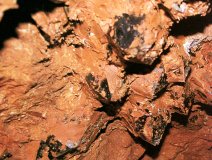 |
 |
 |
 |
| �������̌����Q (Quartz crystals in pocket) | |||
 | |||
| ���o���ꂽ��Ύ������� (Recovered gemmy crystal fragment) |
�@�����w�ɔ��������Z�I���ꂽ ����(15cm)�@�Ɩ����I �@(Deeply etched crystals 15cm high and etched pebbles 5cm) |
�A�i�C�z�R�Y�����̐F���� (Color variations of Anahi quartz) �@5.66�`28.82ct |
�ŏ�̐F�����̃��[�X �E��@367ct (The best color faceted stones) |
�@�@�A�i�C�z�R�ł̓A���g�����̑��ɁC�������ƓV�R�ɂ͋H�ȉ������C����ɖ��F�̐����C�������Ɠ�F�ƁC���ʂȐF�����̐������̂�܂��B�@���Ƌ��F�̓�F�̐������L���ł����A���̓A�i�C�Y�̓V�R�ɂ͋H�ȋ��F�̐����͑��ɗ�����Ȃ��قǖ��f�I�ȐF�����ł��B
�@�����͕��̓����F�̐Ήp���甭�B���C�����̐�[�Ɍ������ɏ]���ĐF���Z����Ύ������������Ȃ�܂��B
�@�@37kg�]��̌�����1942g�̕�Ηp�ɓK�������t�������܂����A�ŏI�I�ɃJ�b�g���ꂽ���[�X��1760ct�i352g�j�ɉ߂��܂���B�����܂�͂P%��ɂ����Ȃ�܂���B
�@�A�i�C�z�R�ł͌��Ԃŕ���5�g�����x�̌����̌@���Ă��܂������ϓI�ȃ��[�X������5���J���b�g��������v�Z�ɂȂ�܂��B
�@Anahí mine produces, in addition to ametrine, amethyst, rare natural citrine, colorless quartz and by-colored citrine-colorless quartz. Quartz crystals grow from milky base quartzite and crystals have deeper color on top of the crystal.
�@To assess the gem yield of typical Anahí mine run, one ametrine clustr weighing 37.5kg was cobbed , preformed, and cut yielding 1,763 ct of faceted stone from 1,942 grams of gem rough. These recoveries of less than 1% correspond closely to those obtained by cutting operations that process of ametrine.
�@
�@�@�@
�@�A�i�C�z�R�̐����̐��� �iAnahí quartz mineralization�j
�@�������̎�v�ȎY�n�ɂ͂��ꂼ��ŗL�̐���������܂��B���I��O�����f��h��X�[���ł͒�������_���̌�����n�◬�ɏo�����������ɐ������������܂��B
�@�}���o�A�W���R�r�[�i�A���B�g���A��_�E�R���L�X�^�ł͌]���]�����⒆�̐������A�����̓~�i�X��W�F���C�X��G�X�s���g��T���g�̂悤�ȃy�O�}�^�C�g�̐Ήp�R�A���ӂł̐����̌�������p������\�I�ȗ�ł��B
�@����A�i�C�z�R�͑��̎������Y�n�Ƃ͈قȂ鐬���Ő������o���܂����B
���̐}�̂悤�ɔM���̈��͂Ō����ΊD��w���j�ӂ���C����ɂ���ďo�����ɐN�����ΊD��Ɣ��������A���J�����̔M���n�t���琅�������������Ƃ����ɂ߂Ĉٗ�̎Y��ł��B
�@���ꂱ�������E�ŗB��̓V�R�̃A���g�������o���������ł�����̂ł��B
�@All other significant amethyst deposits in production today occur as geodes in intermediate-to-acid flows in flood basalt provinces (Rio grande do Sul), as veins in quartzites and quartz-arenites(Maraba, Jacobine, Vitori da Conquista), or as late-stage crystallization around the quartz cores of pegmatites (Minas Gerais and Espirito Santo).
�@The geologic conditions in which the Anahí ametrine deposit formed , hosted by carbonate rocks displaying evidence of hydrothermal brecciation, are fairly unusual, which is the vital factor to grow unique natural ametrine crystal.
�@
A�@�@ �M�����Z�ΐF�̐ΊD��w�ɐZ�����Ĉ��͂����܂�
The hot mineralized upward solutions may reach a barrier
then get trapped and hydrostatic pressure builds up.B�@�ΊD��w���j��ɔM�����N�����Đ�������������
When the rocks burst open, the newly created fractures allow
the solution to migrate again to lead rapid mineral precipitation.
���F�̌����@�iCause of color�j
���Ɖ��F�̑w�Ƃɕ����ꂽ��������
(Cross-sections through large complex crystals)�O�F�̕����̐�������
�iMicroprobe analysis across the three color sectors)
���F���� �@�@�@ ���������@�@�@�@ ��������
(colorless - citrine�@�@ -�@ amethyst)
�@
���F�[��A���A���F�̕����̐ԊO���X�y�N�g���X�R�[�v���́iInfrared specroscope analysis�j �ԊO���X�y�N�g���X�R�[�v�ɂ�鉩�[��A���A���F�̕����̕��͂ł́A���[��̃V�g�����������ł������z�������������Ă��܂��B���̓�����OH-�Ɉ�����̂ł��B�����������ɂ�葽���̐�������荞�܂ꂽ�����������A��̃K���}���̉e����Ď��ɂȂ炸�ɉ��F�[��̃V�g�����ɂȂ����ƍl�����܂��B
�@Infrared spectroscopy also showed differences between the orange-yellow and purple sectors. The broad band absorption of citrine sector is attributed to small groups of water molecules trapped in the quartz astructure during crystal growth.
������c���ɒ��p�ɐؒf����Ǝ��Ɖ��F�Ƃ̕������͂�����Ƌ敪����Ă��܂��B
���ꂼ�ꒅ�F���ꂽ�����̃G���N�g�����}�C�N���v���[�u�ɂ�镪�͂ł͕s�����̓S���̔Z�x���傫���قȂ�܂��B
�@���F�̕����̓S���Z�x�͕���17ppm�ȉ��A���̕�����19�`40ppm�A���F�̕�����68�`125ppm�ƍł������l�ł��B
�@�������̂�����̔��F�̌����ł���A���~�j�E���̔Z�x�̓}�C�N���v���[�u�̌��m���x���E�ɋ߂����߂ɂ͂�����Ƃ͊m�F�ł��܂���B
�@���������̔��F���قȂ闝�R�͂��ꂼ��̒��F���Ɋ܂܂��S�C�I���Z�x�̈Ⴂ�ɂ��ƍl�����܂��B
���F�͌��������Ɠ����ɍ����̔M���ɂ����M�ƁA�M���̃A���J�������Ɋ܂܂�Ă�����ː��̃J���E��40�̕���ɂ��K���}���Ǝ˂��Ď������ƂȂ����ƍl�����܂��B
�@���F�̃V�g�������c�����̂͂����ɂ�葽���܂܂�鐅�����K���}���Ǝ˂Ŏ_�f�C�I���Ɛ��f�C�I���Ƃɕ������A���f�C�I�������̔��F�̌����ƂȂ�Fe4+�̃J���[�Z���^�[�̔�����}�������̂ł͂Ȃ����Ɛ��肳��܂��B
�@
�@�A�i�C�z�R�����E�ŗB��̓V�R�̃A���g�����Y�n�ƂȂ����̂́A�M���ɂ��ΊD��w�̔j�ӂƂ����H�ȏ������ŃA���J�������̋����M�����ʼn��x�ƌ����������x�Ƃ������ɃR���g���[�����ꂽ���߂ł��낤�ƍl�����܂��B
�@When crystal is cut perpendicular to C-axis, orange-yellow, purple and colorless zones are seen clearly separated each other. These zones are analyzed by electron microprobe to determine differences in Fe and Al contents. The result indicate that the orange-yellow sectors invariably have a higher iron(Fe) content(68-125ppm) than the purple(19-40ppm) or the colorless(�`17ppm) sectors. Purple amethyst color is attributed to both heating by high temperature solutions and Gamma-irradiation from 40K, which derives from hydrothermal solutions, reacted with limestone. Orange-yellow color is explained as follows : The high water content undergoes radiolysis(the breakdown of water into O2 and H2 by nuclear reactions) during natural irradiaion, and the H2 generated quenches the Fe4+ color center, preventing the development of the amethyst color.
�@The geologic conditions in which the Anahí ametrine deposit formed, hosted by carbonate rocks displaying evidence of hydrothermal brecciation, are highly unusual. The silica -bearing fluids probably became alkaline by reacting with the limestone host rocks. We can speculate that that the Anahí
���̔��F���������R�ƕ������̂� (Complex color distribution in ametrine)
�ł͉��́C��̌����̓����̒��F����������Ƌ敪����Ă���̂ł��傤���@�H
���̎ʐ^�Ɛ}�Ƃ́C���������̕H�ʕ��ƒ��Ƃ��X���C�X�������̒��F�����̕��͂ł��B
C�͒ʏ�̌��CD�͌����Ό��CA��B�͐}�����������̂ł��B
�@�����Ό��Ō������Ɍ�����Ȗ͗l�͔����҂Ɉ���Ńu���[�X�^�[�ȁiBlewster fringes�j�ƌĂ�܂����C�o����Ό��Ŋώ@�����ꍇ�Ɍ�������̂ł��B
�@�a�}�ŎȂ̊Ԃ�R��L�Ƃ���̂͌������E�����ƍ������Ƃ����݂ɏd�Ȃ��Ă��鎖�������܂����C���̂悤�Ȑ����̌����̓u���W�����o���ƌĂ�܂��B
�@����Ȃ̂Ȃ����F�̕����͒P�����ł��鎖��������܂��B
�@�����A�i�C�z�R�̓�F�̐����͒P�����̉������ƃu���W�����o���̎������Ƃ���̂ƂȂ�C���ꂼ��̌������S��A���~�j�E���̕s�����␅���̕�L����I��I�ɍ̂荞�݂����������߉��F�Ǝ��Ƃ̔����Ȕ��F�̍������ꂽ���̂ƍl�����܂��B
�@The most striking characteristic of ametrines is their complex color distribution. This color zoning is fairly consistent : The major rhombohedral z sectors are orange-yellow. The purple r sectors are invariably Brazil-twinned with both right-and left-handed quartz. This can be established by viewing a slab with polarized light. The boundaries between left-and right-handed qurtz appear dark under crossed polarizers and these patterns are known as Brewster fringes.
�@
���z�I�ȃA���g���������̃X���C�X �iA slice of an idealized ametrine crystal�j �P�����̃V�g��������(Z)���u���W�����o������(r)�Ƃ�
���݂Ɍ��������Ό��ɂ��u���[�X�^�[�Ȃ̐}
The boundary between r (Brazilian twin ametyst)
and z (untwinned citrine) sectors apears parallel���ʂ̌��Ō������F�敪
�iviewed by ordinary light)�Ό��Ō������F�敪
(viewed by crossed polars)
�����e�B�z�R�iYuruty Mine�j
�@�A�i�C�z�R�̖k�A50km�قǂɐV���ȃA���g�����z�R��1990�N�㔼�ɔ�������A�f���I�ȍ̌@���s���Ă��邱�Ƃ����炩�ɂȂ�܂����B
�@���炭�Y��̓A�i�C�z�R�Ɠ����Ǝv���܂��B
1990�N�㖖�ɂ�90m�ɒB����c�B�ƍő��200m�ɒB����4�{�̃g���l�����@���A100�l�̍z�v������40�g���̌����̌@���Ă���Ƃ̂��Ƃł��B
�@���̂���3%�قǂ��t�@�Z�b�g�i���Ƃ̂��ƁB�ʐ^�̂悤�ɃA�i�C�Y�Ɠ��l�̕i���ł��B27.3 - 299.7ct 6.46 -�@35.59ct
�@Yuruty Mine, new ametrine deposit, locaterd 50km north of the famous Anahí mine,�@was claimed in mid-1990s.
�@The deposit is exploited by �`100 people in underground workings consisting of a 90m shaft and four horizontal tunnels up to 200m long. The operation has been intermittent, but produces an average of �`40 tonnes/month of mixed grade material, approximately 3% of which is facetable. Yuruty ametrines have equivalent appearance as Anahí ones.
�A���g�������g�����V������̃J�b�g�ƃf�U�C��
(Modern design and faceting of ametrine)�@
Gem carving and Jewelry designed by�@Michael�@Dyber Gem carving and Jewelry designed
by Bernt Munsteiner 78ct142ct �@�@ �@44ct 263ct 68.9ct
�@�A���g�������s��ɏo�n�߂Ă���1970�N��㔼�܂ł͉��F�̃V�g�����̕����͗]�v�ȕ����Ƃ��ď�����Ă��܂����B
�@�������C�g���}�����̏ꍇ�͑��F�̌����̓����������������[�X���s��ɏo�Đl�C������܂����B
���Ɖ��F�̓�F�̑g�ݍ��킹�̖ʔ����ɒ��ڂ����f�U�C�i�[���Ǝ҂������Â�F�̃��[�X���s��ɏo���悤�ɂȂ�܂����B
�@�ŋ߂ł̓��[�U�[�ɂ�镡�G�ȉ��H���\�ƂȂ�C�P�Ȃ郋�[�X�����ł͂Ȃ����x�ȍH�|�i�Ƃ��Ď��R�ȃt�H�����̍�i�����y���n�߂Ă��܂��B
�@�Ƃ�킯�傫�Ȍ����������ɓ���ł���A���g�����͐�o���p�x�ɂ���đ��ʂȐF�̑g�ݍ��킹�ƌ��ʂƂ������ł��邽�ߖ��͓I�ȍ�i���d�オ��܂��B
�@Until the late 1970s, most of the rough material from Anahí was selectively sawed , and only the amethyst sectors were used because the citrine color was considered undesirable. However, if tourmaline could be marketed in bicolored stones, then why not market bicolro quartz, some designers and gem dealers suggested. Then ametrine has become an important medium for some unusaul works of gem art and new fashioning techniques that incorporate amethyst and citrine sectors as part of an overall work of art have recently come into vogue.
�@�@�@�@�@�@�����A���g���� (Synthetic ametrine)�@
��(left) �����A���g����(Synthetic�@ametrine) 11.3-13.4ct�@
������E(center & right)�@
�V�R�A���g���� (Natural ametrine) 4.7-35ct
���F�̍�������
(Multicolor Synthetic Quartz)
8.46ct�@21.02ct 18.45ct�����A���g��������
(Synthetic ametrine crystals)�@20cm�@1.1kg
���@�K���}�ƎˑO�̌���
(left : crystal before gamma radiation)�@
�E�@�Ǝˌ�̌���
(right: crystal after radiation)�X���C�X�ƃ��[�X
8�|20ct
slice and faceted stones
�@1994�N���C���V�A���̍����̃A���g�������s��ɓo�ꂵ�Ă��܂����B
���V�A�͐��X�̕�����Z�p�Ő��E�̃��[�_�[�ƂȂ��Ă��܂����C�A���g����������1950�N�㖖����1960�N�㏉�߂ɂ͎������̒i�K�Ŏ������Ă��܂����B
�@���������F�̎d�g�݂ɂ��Ẳ𖾂��i�̂�1977�N���ŁC���ƃx�[�X�̗ʎY�ւ̎��݂�1982�N���Ɏn�߂��Ă��܂��B
�@������1994�N�ɂ͗ʎY�Z�p���m������100kg���̎���i�����Y����܂����B
�@2000�N�����ɂ͂͌���2�`3kg���x���o�ׂ���Ă����悤�ł����C���Y�\�͂͌��Y300kg�܂łɑ�������C���v������ΔN�Ԑ��g���܂ł͋����ł���Ƃ̂��Ƃł��B
�@���Y�͑S�ă��X�N���x�O�ɂ���VNIISIMS�i���@�������������j�̌������ōs���Ă��܂��B
�@Synthetic quartz with the distinctive amethyst-citrine bi-coloration was first mentioned in the russian scientific literature in the late 19450s and early 1960s. In fact, the efforts were underway in Russia in 1977 to understand the fundamental mechanisms of synthesizing ametrine. By 1994, the growth techn ology was successfully established , and the first commercial batch(on the order of 100kg) of synthetic ametrine crysals was produced.�@In early 2000�Aa few kilograms per month of synthetic ametine crystals and polished slabs were being sold. Batch capacity has grown to more than 300kg.�@If necessary to meed demand, several tons of synthetic ametrine a year could be produced by a single laboratory (the Russian Research Institute for Material Synthesis :�@VNIISIMS�j
���V�A�Y�����A���g�����̋Z�p�̊T�v�@�iScientific foundations for the growth of synthetic ametrine�j
�@
�@�A���g�����̍����͉������⎇�������Ɠ����M���@�ɂ�荇������܂��B
�Y�_�J���E�����܂ރA���J�����̗n�t���ɂĉ��x��330�`370���C���͂�1200�`1500�C����1000�`1500���b�g���̓��e�ς����I�[�g�N���[���ƌĂ�鍂�����e��ɂČ������������܂��B
�@�������Ɖ������̔��F�͂�������s�����̎O���̓S�C�I���̔����ȓd�����̈Ⴂ�Ɉ����ċN����܂��B
���V�A�̉Ȋw�ҒB�͔M���n�t���ɂǂ̂悤�ȏ����ŎO���̓S�C�I�������݂���̂���Njy���܂����B
�@���ꂪ���L��Eh(�_���|�e���V����)�Ǝ_���x�Ƃ̑��֕\�ł��B
������̕\�͌����������x�ƐF�̔Z���Ƃ̑��֕\�ł��B
�@�A���g�����̍����ɂ͔M���̎_���|�e���V�����Ǝ_���x�A����Ɍ����̐������x�Ƃ̎O�̏������ɃR���g���[�����邱�Ƃ��s���̏����ł��B
�@���̂��ߌ����̐����͕��ʂ̐�����1mm/���Ɣ�ׂ�10�{��������܂��B
��L�̎ʐ^�̂悤�ɐ������������͊O�������F�Œ��g���V�g�����ł����C�R�o���g60�ɂ�邨�悻3���Ԃ̃K���}���̏Ǝ˂ŊO�������ɕς��܂��B
�@�V�R�Ɣ�ׂăV�g�����̕����̐F���Z������̂ŁC330�`350���łP���Ԃ̉��M�����ɂ��F�𔖂߂Ă���J�b�g����܂��B
�@The technology for synthesizing ametrine is similar to that of other synthetic quartz. The crystals are grown hydrothermally in concentrated alkaline (K2CO3) solutions at temperatures of 330���[370�� and pressures in the range of 1,200 to 1,500 atmospheres, in autoclaves of 1,000 to 1,500 liters in volume.
�@Because the color of iron-bearing quartz depends on the valence state of the iron, the Russian researchers first had to determine the conditions under which the desired form of iron ions would exist in the quartz-forming hydrotherml solutions. They did this with the help of a calculated diagram (known as an Eh-pH diagram, which shows the stability of ionic and molecular forms of iron in aqueous solution as a function of the oxidation potential(Eh) and that there is a limited regime under which all the iron will be in the trivalent state.�@Another diagram shows how the color intensity is directly related to the quantity of captured iron impurities.
�@The growth conditions ( Eh, pH and growth rate) must be closely regulated so that the amethyst-and citrine-forming iron impurities are captured simultaneously by different growth sectors in a crystal. The crystal growth rate of ametrine is almost 10 times slower than that of other synthetic quartzs. The external sector of grown crystal is colorless, which is irradiated by cobalt-60 gamma ray for about 3 hours, resulting in a dose of about 5 Mrads for maximum amethyst color saturation. To fulfill customer requests, occasioally the crystals are heat treated (at 330��-370�� for one hour) to reduce the color intensity of the synthetic citrine portion.
�@
�_���|�e���V���� (Eh) �Ɨn�t pH ���֕\
Eh:Oxidation potential and pH diagram�����������ƐF�Z�x�̑��֕\
�iGrowth rate and Color intensity diagram�j�@Vrcr�F���������ʂ̐F���ł��Z���Ȃ�ő�̐������x�_
�@�@�@�@�@(Critical growth rate for r face)�@Vzcr�F���������ʂ̐F���ł��Z���Ȃ�ő�̐������x�_
�@�@�@�@�@(Critical growth rate for z face)1 �������F�@����@
(purple and yellow region)�@V�@�@�@�F �@���ʂ��������ɂȂ�ő听�����x���E
�V�W�X :�@���ʂ��������ɂȂ�ő听�����x���E
�@�@�@�@(At higher growth rates, the r and z faces
�@�@�@�@�@�@�@�@incorporate only citrine-forming impurities)�@2 ���F�̈� (brown region)
3 �Η̈� (green region)
�V�R�ƍ����̃A���g�����̎��� (Separation of natural and synthetic ametrine)
�����A���g�����ɋH��
�����镡�G�ȃu���W��
�o���̊��� �@15���V�R�A���g�����̃u���W����
�o���ɂ����G�ȋȐ��p�^�[��
���[�͒P�����̃V�g�������V�R�̃u���W���o����
�A���g�����Ɍ�����
�u���[�X�^�[�������A���g�����ɋH�Ɍ����
�t�̂ƋC�̂̓�
��L���@�@10�������A���g�����̃V�g����
�����Ɍ���闬����̍\��Brazil twins are observed
only rarely in the�@amethyst portion of synthetic ametrineBrazil twins in the amethyst portion of natural ametrine form complex curved patterns Some natural samples show distinctive curved Brazil-twins by thedarker Brewster fringes Needle-like two phase (liquid-gas) inclusions seen only rarely in the citrine portion of the synthetic ametrine Stream-like structures are visible in nthe citrine portion of this synthetic ametrine
�@�A���g�������{���r�A�Y�̓V�R�ł���Ɣ��������̂�1993�N�ł����C���̗��N�ɂ̓��V�A���獇���̃A���g�������s��ɓo�ꂵ�܂����B
�@��{�I�ɂ͓V�R�ŏo����̂Ƃقړ���̏������Č����č��������킯�ł��B
�����̗ǂ����������𑣂����ߍ����i�̌����͓V�R�ɂ͌����Ȃ�����ł�����C�����̌`�͓V�R�ƍ����i�Ƃł͑S���قȂ�܂��B
�@���̓J�b�g���ꂽ���ł����C���_���Ɍ����C���ʂ͕s�\�ł͂���܂���ύ���ł��B
�@The ametrine of Bolivian origine was revealed in 1993. And the Russian synthetic ametrine appeared in the market the next year. Both natural and synthetic ametrines were grown under the similar conditions and the difference is the crystal shape.
�@Therefore, it will be quite difficult to separate them when polished into faceted stones.
�@�����A���g�����Ɍ�������� (Characteristics of synthetic ametrine)
�P
������͈�ʂɓV�R�̍ō����i��ڎw���Ē��F�������ő���Y�����邽�߁C�V�R�̕��ϓI
�Ȃ��̂Ɣ�ׂ�ƔZ���F�����ƂȂ�B
�@
�@In general, synthetic gemstones are often intensely colored than natural ones.
�Q �������̕����Ǝ������̕����Ƃ̋��ڂ̓������V�R�ƍ����ł͈قȂ�B
�@
�@Faceted natural ametrine commonly displays a sharp, strait boundary between the citrine and amethyst portions.
�R �����A���g�����̃V�g���������ɂ͓V�R�ɂ͌����Ȃ�������̍\����������B
�@
�@The crystalographic orientaions of the color zones and the rare
stream-like structures in the synthetic citrine portions are distinctive.
�S �V�R�A���g�����̎������̕����̓u���W�����o���ŁC�����u���[�X�^�[�Ȃ�������B
�����������̏ꍇ�ɂ͂�͂�u���W�������������V�R�̂悤�Ȃ͂�����Ƃ����u���[�X�^�[
�Ȃ͖w�nj����Ȃ��B���ɂ�镡�G�ȃp�^�[�����o��B�V�R�̏ꍇ���ގ��̃p�^�[�����o
�邱�Ƃ�����̂ł��̑��̓����ƕ����đ����I�ɔ��f����K�v������B
�@
�@In the amethyst portions of naturasl metrine, Braziil-law twinning is almost alwasy present, and Brewster fringes are often observed.
However, Brazil twinning was seen only rarely in the amethyst portions of synthetic ametrine, in the form ofj subtle parallel twin lamellae.
�T �V�R�A���g�����ɂ͉t�́[�C�̂̓̕�L�����ǂ������܂����C�����̏ꍇ�ɂ͋H�B
�@
�@Irregular planes of two-phase inclusions are commonly observed in both color portions of natural ametrine, while they are rarely seen in synthetics.
�U �ԊO���z���X�y�N�g���̓������Ƃ�킯�V�g���������œV�R�ƍ����Ƃł͑傫�ȍ�������B
�@
�@Natural and synthetic ametrine can be usually separated by their infrared spectra.
�V EDXRF�i�G�l���M�[���U�^X�������@�j�ɂ�镪�͂ō����A���g�����͓V�R�Ɣ�ׂ�
�J���E���C�}���K���C�����C�S���s����������
�@
�@EDXRF chemical analysis shows highercontents of K, Mn, Fe, and Zn in synthetic ametrine.
�ƁC�n���������Ƃ����x�ȋ@�ނ���g���ďڍׂɒ��ׂ�Ύ��ʂ����Ƃ������Ƃł����C�����o���̂����Ώ����܂߂Ĉ�ʐl�ɂ͕s�\�ƌ������ق��������I�ł��B
�@�܂������A���g�����ƓV�R�A���g�����̊Ԃɑ傫�ȉ��i��������܂���B
����������ʂ̂��̂Ȃ�J���b�g����T�`�P�O�h�����炢�̐����ł��B�@
�@�������ƂɊӕʂ��˗�����Ƃ��̔�p�̕�����Ύ��̂��y���ɍ����Ȃ�܂��B
�@These characteristics tells that it is possible to separate ametrine if they are natural or synthetics, but only when examined by expert gemologist, using the most advanced equipments. Since there are not significant price diffences between natural and synthetic ametrine, both commonly sold around USD$5 to 10 per carat, verification cost at laboratory will be more expensive than the stone value itself.
�@�@����1999�N������u���W���̎s��œV�R�̃A���g�����ɍ������č����i������n�߂��Ƃ̂��Ƃł��B
�ԈႢ�Ȃ��A�i�C�Y�̓V�R�ł���Ƒf�����͂����肵�Ă��邱�Ƃ��m�F�ł���悤�ȕ�ΓX�œ��肷�邩�C���邢�͂�����������悤�Ȓl�i�Ȃ̂�����V�R�ł��낤�ƍ����ł��낤�ƈ���ɋC�ɂ��Ȃ��Ƃ������ԓx�ŗՂނ���������܂���B
�@Already since 1999, synthetic ametrines began to appear mixed in natural ametrine parcels in Brazilian market. It will be recommended to buy ametrine through qualified gemstone dealers. Or ignore origines since they are certainly the real ametrines, whatever natural or synthetics.
�@